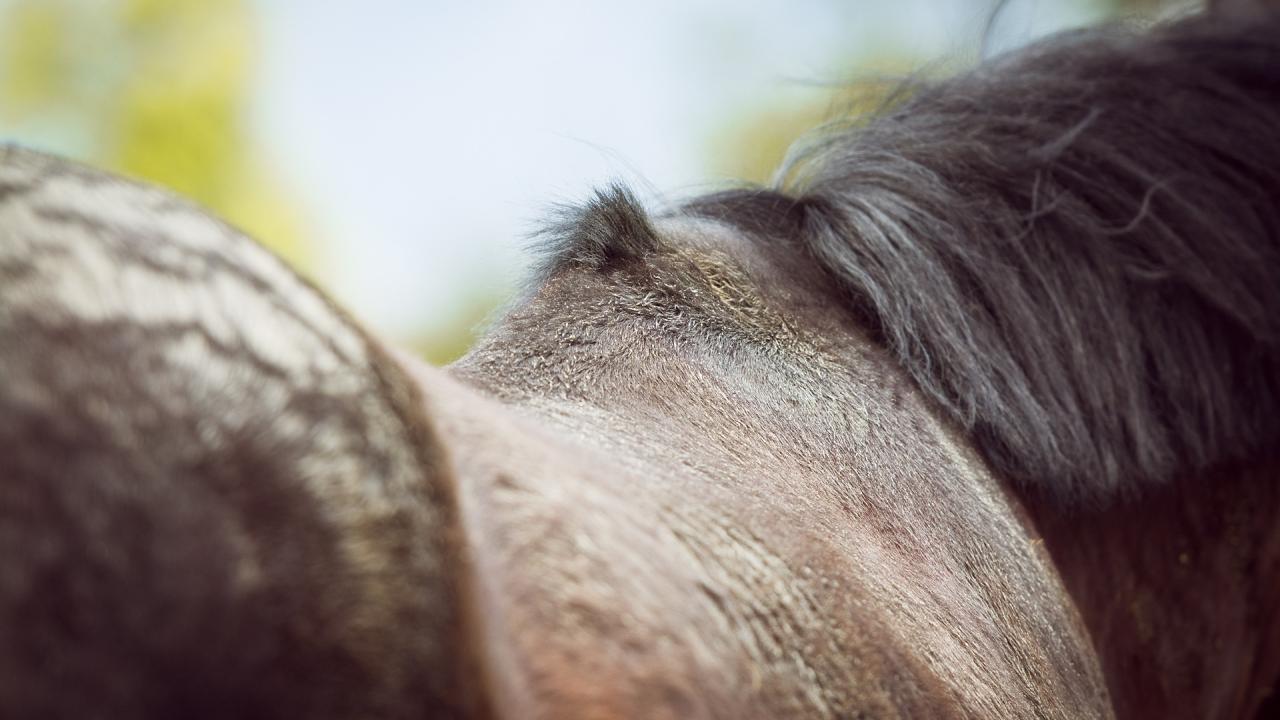
Silicate Associated Osteoporosis (SAO)
What is silicate associated osteoporosis?
Takeaways
- Silicate associated osteoporosis (SAO) is a bone fragility syndrome characterized by extensive bone loss (osteoporosis) and remodeling.
- Cases of SAO cluster in geographic regions known for soil that contains high levels of cytotoxic silicates, which are aerosolized and inhaled as silicate particles.
- Affected horses may exhibit intermittent lameness of an indeterminable cause. As the disease progresses, bones become weak, which eventually leads to deformities and incomplete bone fractures.
- There is no cure for SAO. Treatment primarily involves inhibition of bone resorption to delay disease progression and pain management.
Silicate associated osteoporosis (SAO) is a bone fragility syndrome characterized by extensive bone loss (osteoporosis) and remodeling. It preferentially affects the bones of the upper parts of limbs (scapula, pelvis, etc.), ribs, and vertebral spine. Typically, the first sign of SAO is intermittent lameness with an unknown cause. As the disease progresses, bones become weak, which eventually leads to deformities and incomplete bone fractures that attempt to heal. The condition is debilitating and ultimately fatal.
Cases of SAO cluster in geographic regions known for soil that contains high levels of cytotoxic (cell damaging) silicates, which are aerosolized and inhaled as silicate particles. These silicate crystals are also associated with the lung disease silicosis. Many, but not all, SAO-affected horses also exhibit lung silicosis.
What are the clinical signs of silicate associated osteoporosis?
Mildly affected horses exhibit intermittent lameness without an identifiable cause. This can affect one or more legs or different legs at different times. Affected horses may also exhibit general stiffness, reluctance to move, reduced neck mobility, and exercise intolerance. They may have a loss of appetite and severe weight loss.
The lameness can progress in severity and distribution. Affected horses ultimately develop multiple debilitating skeletal deformities, which can include bowing of one or both scapulae (shoulder region), bowing of the rib cage, and lordosis (swayback) that occurs in a relatively short period and is not due to advanced age. Osteoporosis in the neck can contribute to a decreased range of motion of the head and neck so that turning the head and eating off the ground become difficult. Severely affected horses develop skeletal pain and bone fractures.
Clinical signs of SAO can develop even years after moving away from geographically impacted areas, with the disease most commonly occurring in horses that have experienced long-term exposure.
How is silicate associated osteoporosis diagnosed?
A diagnosis of SAO is made based on results of bone scan (nuclear scintigraphy) which can identify areas of bone loss. Ultrasound may reveal thickening of the shoulder blades or ribs or evidence of fracture. These findings combined with physical examination and history of where the horse has lived. Routine blood and urine tests usually return normal results. Radiographs of the vertebrae of the neck may be useful in moderately to severely affected horses.
Diagnosis is often straightforward in severely affected cases but in the early stages can be challenging. The most common complaint in these instances is a horse with a mild or intermittent lameness without an identifiable cause.
How is silicate associated osteoporosis treated?
There is no cure for SAO and treatment is primarily supportive. Pain management is achieved through administration of non-steroidal anti-inflammatories (NSAIDs) such as phenylbutazone or flunixin meglumine, or steroids such as dexamethasone or prednisolone. Bisphosphonates have been effective in prolonging disease progression. Zoledronate, tiludronate or clodronate have been used with some success.
What is the prognosis for silicate associated osteoporosis?
The prognosis for SAO is grave. Treatment with bisphosphonates can prolong the progression of the disease, but affected horses may die due to catastrophic bone fracture or require humane euthanasia.
How can silicate associated osteoporosis be prevented?
Prevention of SAO requires dust control to avoid inhalation of toxic crystals. Dust abatement strategies can include planting and irrigating affected areas, as well as distributing material that retains moisture and reduces dust, such as wood chips and topsoil.
For more information
Silicosis Associated Osteoporosis: An Emerging Equine Bone Disease, UC Davis J.D. Wheat Veterinary Orthopedic Research Laboratory
Zavodovskaya, R., Stover, S.M., Murphy, B.G., Katzman, S., Durbin-Johnson, B., Britton, M., Finno, C.J. 2018. Bone formation transcripts dominate the differential gene expression profile in an equine osteoporotic condition associated with pulmonary silicosis. PLoS One 13(6): e0197459.
Arens, A.M., Puchalski, S.M., Whitcomb, M.B., Bell, R., Gardner, I.A., Stover, S.M. 2013. Comparison of the use of scapular ultrasonography, physical examination, and measurement of serum biomarkers of bone turnover versus scintigraphy for detection of bone fragility syndrome in horses. J Am Vet Med Assoc 242(1):76-85.
Katzman, S.A., Nieto, J.E., Arens, A.M., MacDonald, M.H., Puchalski, S.M., Galuppo, L.D., Snyder, J.R., Maher, O., Bell, R.J.W. 2012. Use of zoledronate for treatment of a bone fragility disorder in horses. J Am Vet Med Assoc 240(11):1323-8.
Symons, J.E., Entwistle, R.C., Arens, A.M., Garcia, T.C., Christiansen, B.A., Fyhrie, D.P., Stover, S.M. 2012. Mechanical and morphological properties of trabecular bone samples obtained from third metacarpal bones of cadavers of horses with bone fragility syndrome and horses unaffected by that syndrome. Am J Vet Res 73(11): 1742-51.
Arens, A.M., Puchalski, S.M, Poppenga, R., Kulin, R.M., Anderson, J., Stover, S.M. 2011. Osteoporosis associated with pulmonary silicosis in an equine bone fragility syndrome. Vet Pathol 48(3): 593-615.
